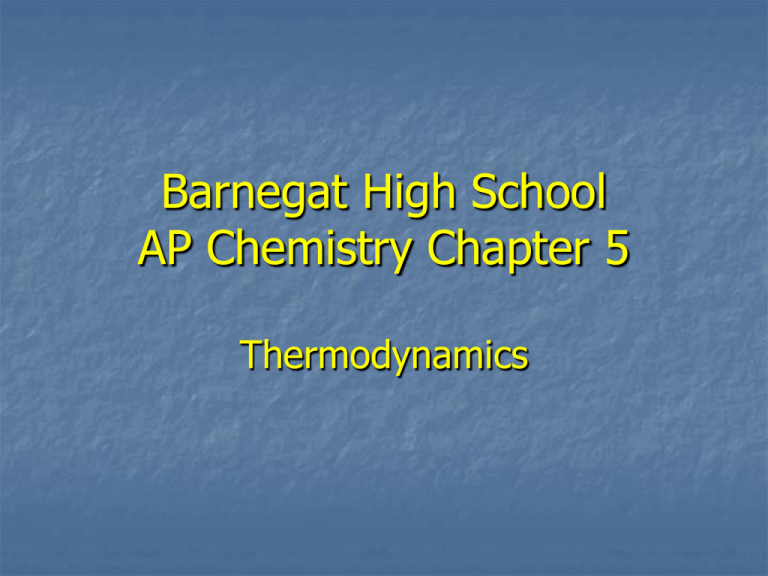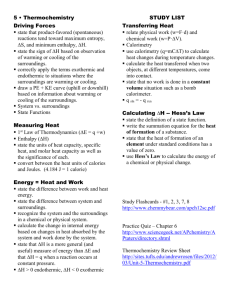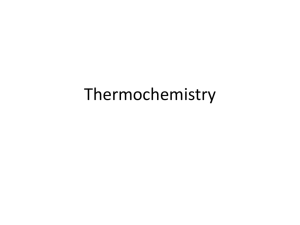
Barnegat High School
AP Chemistry Chapter 5
Thermodynamics
System
Surroundings
State
property – depend only on
the state of the system, not on
the way the system reached the
state
System and Surroundings
• The system includes the
molecules we want to
study (here, the
hydrogen and oxygen
molecules).
• The surroundings are
everything else (here,
the cylinder and piston).
volume
– state property
heat flow – not a state property –
value depends on how the system
reached that state.
The universe
is divided into two halves.
the system and the surroundings.
The system is the part you are concerned
with.
The surroundings are the rest.
Exothermic reactions release energy to the
surroundings.
Endothermic reactions absorb energy from
the surroundings.
Energy
The ability to do work or transfer heat.
Work: Energy used to cause an object that
has mass to move.
Heat: Energy used to cause the
temperature of an object to rise.
Potential Energy
Energy an object possesses by virtue of its
position or chemical composition.
Initial Position
In the initial position, ball A has a higher
potential energy than ball B.
Copyright © Houghton
Mifflin Company. All
rights reserved.
6–8
Final Position
After A has rolled down the hill, the
potential energy lost by A has been
converted to random motions of the
components of the hill (frictional heading)
and to the increase in the potential energy
of B.
Copyright © Houghton
Mifflin Company. All
rights reserved.
6–9
Kinetic Energy
Energy an object possesses by virtue of its
motion.
1
2
KE =
mv
2
Units of Energy
• The SI unit of energy is the joule (J).
kg m2
1 J = 1
s2
• An older, non-SI unit is still in widespread
use: The calorie (cal).
1 cal = 4.184 J
Work
• Energy used to move
an object over some
distance.
• w = F d,
where w is work, F is
the force, and d is the
distance over which
the force is exerted.
Work needs a sign
• If the volume of a gas increases, the system
has done work on the surroundings.
• work is negative
• Expanding
work is negative.
• Contracting surroundings do work on the
system w is positive.
Heat
• Energy can also be
transferred as heat.
• Heat flows from
warmer objects to
cooler objects.
First Law of Thermodynamics
• Energy is neither created nor destroyed.
• In other words, the total energy of the universe is a
constant; if the system loses energy, it must be gained
by the surroundings, and vice versa.
Use Fig. 5.5
Internal Energy
The internal energy of a system is the sum of all
kinetic and potential energies of all components of
the system; we call it E.
Use Fig. 5.5
Internal Energy
By definition, the change in internal energy, E, is the
final energy of the system minus the initial energy of
the system:
E = Efinal − Einitial
Use Fig. 5.5
Changes in Internal Energy
• If E > 0, Efinal > Einitial
– Therefore, the system
absorbed energy from
the surroundings.
– This energy change is
called endergonic.
Changes in Internal Energy
• If E < 0, Efinal < Einitial
– Therefore, the system
released energy to the
surroundings.
– This energy change is
called exergonic.
Changes in Internal Energy
• When energy is
exchanged between
the system and the
surroundings, it is
exchanged as either
heat (q) or work (w).
• That is, E = q + w.
E, q, w, and Their Signs
• Text Pg. 171 Sample Exercise 5.2
Work vs. Energy Flow
Copyright © Houghton
Mifflin Company. All rights
reserved.
6–23
Exchange of Heat between
System and Surroundings
• When heat is absorbed by the system from the
surroundings, the process is endothermic.
Exchange of Heat between
System and Surroundings
• When heat is absorbed by the system from the
surroundings, the process is endothermic.
• When heat is released by the system to the
surroundings, the process is exothermic.
State Functions
Usually we have no way of knowing the internal
energy of a system; finding that value is simply
too complex a problem.
State Functions
• However, we do know that the internal energy of a
system is independent of the path by which the
system achieved that state.
– In the system below, the water could have reached room
temperature from either direction.
State Functions
• Therefore, internal energy is a state function.
• It depends only on the present state of the system,
not on the path by which the system arrived at that
state.
• And so, E depends only on Einitial and Efinal.
State Functions
• However, q and w are not
state functions.
• Whether the battery is
shorted out or is
discharged by running
the fan, its E is the
same.
– But q and w are different
in the two cases.
Work
When a process occurs in
an open container,
commonly the only work
done is a change in
volume of a gas pushing
on the surroundings (or
being pushed on by the
surroundings).
Work
We can measure the work done by the gas if the
reaction is done in a vessel that has been fitted
with a piston.
w = −PV
Enthalpy
• If a process takes place at constant pressure
(as the majority of processes we study do)
and the only work done is this pressurevolume work, we can account for heat flow
during the process by measuring the enthalpy
of the system.
• Enthalpy is the internal energy plus the
product of pressure and volume:
H = E + PV
Enthalpy
• When the system changes at constant
pressure, the change in enthalpy, H, is
H = (E + PV)
• This can be written
H = E + PV
Enthalpy
• Since E = q + w and w = −PV, we can
substitute these into the enthalpy
expression:
H = E + PV
H = (q+w) − w
H = q
• So, at constant pressure the change in
enthalpy is the heat gained or lost.
Endothermicity and
Exothermicity
• A process is
endothermic, then,
when H is positive.
Endothermicity and
Exothermicity
• A process is
endothermic when
H is positive.
• A process is
exothermic when
H is negative.
Pg. 176 Sample and practice 5.3
Enthalpies of Reaction
The change in enthalpy,
H, is the enthalpy of
the products minus the
enthalpy of the
reactants:
H = Hproducts − Hreactants
Enthalpies of Reaction
This quantity, H, is called the enthalpy of
reaction, or the heat of reaction.
The Truth about Enthalpy
Pg. 178
1. Enthalpy is an extensive property.
2. H for a reaction in the forward direction is
equal in size, but opposite in sign, to H for
the reverse reaction.
3. H for a reaction depends on the state of
the products and the state of the reactants.
• Pg. 179 Sample and practice (most important
out of all the samples)
Calorimetry
Since we cannot know
the exact enthalpy of
the reactants and
products, we measure
H through
calorimetry, the
measurement of heat
flow.
Heat Capacity and Specific Heat
• The amount of energy required to raise the
temperature of a substance by 1 K (1C) is its
heat capacity.
• We define specific heat capacity (or simply
specific heat) as the amount of energy
required to raise the temperature of 1 g of a
substance by 1 K.
Heat Capacity and Specific Heat
Specific heat, then, is
heat transferred
Specific heat =
mass temperature change
Cs =
q
m T
Constant Pressure Calorimetry
By carrying out a reaction
in aqueous solution in a
simple calorimeter such as
this one, one can indirectly
measure the heat change
for the system by
measuring the heat
change for the water in
the calorimeter.
A Coffee
Cup
Calorimeter
Made of
Two
Styrofoam
Cups
Copyright © Houghton
Mifflin Company. All
rights reserved.
6–46
Constant Pressure Calorimetry
Because the specific heat
for water is well known
(4.184 J/mol-K), we can
measure H for the
reaction with this
equation:
q = m s T
Pg. 181 sample
Pg. 182 sample
Bomb Calorimetry
Reactions can be
carried out in a sealed
“bomb,” such as this
one, and measure the
heat absorbed by the
water.
Bomb Calorimetry
• Because the volume in
the bomb calorimeter is
constant, what is
measured is really the
change in internal
energy, E, not H.
• For most reactions, the
difference is very small.
Bomb Calorimetry
• Pg. 184 sample
Enthalpy
Heat
Remember:
qreaction at constant pressure =
∆H = Hproduct – Hreactants
-∆H exothermic
+∆H endothermic
Remember reaction diagrams
Thermochemical equations
Specify ∆H in kilojoules
Workbook Handout – Pg. 158 Read
through and do sample problems - up to
pg. 163
Rules of Thermochemistry Masterton
Handout Pg. 203 -205
Hess’s Law
Summarized on page 206
Rules of Thermochemistry
1. The magnitude of ∆H is directly
proportional to the amount of reactant or
product
2. ∆H for a reaction is equal in magnitude
but opposite in sign to ∆H for the reverse
reaction
3. The value of ∆H for a reaction is the same
whether it occurs in one step or in a series of
steps. Called Hess’s Law
∆H is directly proportional to amount of
reactants or products.
When one mole of ice melts, 6.00 kJ of
heat is absorbed, ∆H = +6.00 kJ
If one gram of ice melts,
∆H = 6.00kJ/18.02 = 0.333 kJ.
In general, ∆H can be related to
amount by the conversion factor
approach
H2(g) +Cl2(g) 2HCl(g)
∆H = -185kJ
When 1.00 g of Cl2 reacts,
∆H = 1.00g Cl2 x 1 molCl2 x -185kJ
=
70.90g Cl2 1 mol Cl2
-2.61 kJ
∆H for a reaction is equal in
magnitude but opposite in sign to
∆H for the reverse reaction
H2O(s) H2O(l)
H2O(l) H2O(s)
∆H = +6.00kJ; 6.00kJ
absorbed
∆H = -6.00kJ; 6.00kJ
evolved
Hess’s Law
If Equation 1 + Equation 2 = Equation 3,
then ∆H3 = ∆H1 + ∆H2
Often used to calculate ∆H for one step,
knowing ∆H for all other steps and for the
overall reaction
C(s) + ½ O2(g) CO(g)
∆H1 = ?
CO(g) + 1/2 O2(g) CO2(g) ∆H2 = -283.0kJ
C(s) + O2(g) CO2(g)
∆H1 = -110.5 kJ
∆H3 = -393.5
Examples Pg. 204 – 205 8.4, 8.5, 8.6
Go over homework for this topic
Heat of Formation, Heats of Reaction
The standard heat of formation (ΔHof) is the change of enthalpy
for the reaction that forms a compound from its pure elements
under standard conditions.
The standard heat of formation (ΔHof) for pure elements at
standard conditions is zero.
Standard heats of formation can be used to estimate the ΔHof of
any reaction.
Put new slide here
Standard States
Compound
For a gas, pressure is exactly 1 atmosphere.
For a solution, concentration is exactly 1
molar.
Pure substance (liquid or solid)
Element
The form [N2(g), K(s)] in which it exists at 1
atm and 25°C.
Copyright © Houghton
Mifflin Company. All
rights reserved.
6–64
ΔHof and heats of formation
ΔHof and heat of formation
ΔHof = ΣHof (products) - ΣHof (reactants)
Enthalpies of Formation
Standard molar enthalpy of formation –
equal to the enthalpy change when one
mole of the compound is formed at a
constant pressure of 1 atm and a fixed
temp (usually 25o C
∆Hof
Can calculate Standard Enthalpy values
∆Ho from these values
The standard enthalpy change , ∆Ho , for a
given thermochemical equation is equal to
the sum of the standard enthalpies of
formation of the product compounds
minus the sum of the standard enthalpies
of formation of the reactant compounds
∆Ho = ∑∆Hof products - ∑∆Hof reactants
Elements in their standard states can be
omitted because their heats of formation
are zero
Use Reference Table on Pg. 207
ΔHof and heats of formation
•
•
•
Example: Calculate the ΔHof for the
reaction,
PbO2(s) + 2H2SO4 (l) + Pb(s) 2PbSO4 (s) + 2H2O (l)
Given the following ΔHof information
•Species ΔHof (kJ)
•PbO2 (s)
-66.3
•2H2SO4
-194.5
•PbSO4 -219.9
•H2O -68.3
•ΔHof = ΣHof (products) - ΣHof
(reactants)
•ΔHof = [(2
x -219.9) + (2 x -68.3)] – [(66.3) +
(2 x -194.5)]
•ΔHof = -121.1 kJ
Pg. 207 Example
Pg. 208 do examples 8.7 and 8.8
•
•
•
•
•
•
Bond energies are the amount of energy given off when bonds are
formed, or the amount of energy used when bonds are broken.
Bond energies deal with reactants and products in their gaseous state
under standard conditions.
Breaking bonds is an exothermic process.
Making bonds is an endothermic process.
Heat of reaction can be estimated by finding the difference between the
bonds made and the bond energies of the bonds broken.
Bond energies used in this way to find heats of reaction is an example of
Hess’s Law.
o
ΔH
and Bond Energies
ΔHo reaction = ΣHo bond energies (bonds broken) - ΣHo
energies (bonds made)
bond
Bond enthalpy always positive
Pg. 211 of Masterton handout – table of bond
enthalpies – heat always absorbed when
bonds are broken
The bonds in the reactants are stronger than
those in the products
And
There are more bonds in the reactants than in
the products
Bond entalpy is larger for a multiple bond
than for a single bond between the same two
atoms
Bottom of pg. 211
First Law of Thermodynamics
◦ The first law of thermodynamics is commonly referred to as the law of Conservation of
Energy.
◦ More specifically, the first law states that the changes in internal energy is equal to the
difference between the energy supplied to the system as heat and the energy
removed from the system as work performed on the surroundings.
The energy of the universe is constant.
Law of conservation of energy.
q = heat
w = work
E = q + w
Take the systems point of view to decide
signs.
In any process, the total change in energy of
a system, E, is equal to the sum of the heat,
q, and the work,w, transferred between the
system and the surroundings
Work is a force acting over a distance.
w= F x d
P = F/ area
d = V/area
w= (P x area) x (V/area)= PV
Work can be calculated by multiplying
pressure by the change in volume at constant
pressure.
If the volume of a gas increases, the system
has done work on the surroundings.
work is negative
w = - PV
Expanding work is negative.
Contracting, surroundings do work on the
system w is positive.
Pg. 213 Example 8.9







